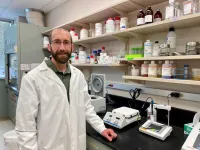(Press-News.org) Rett syndrome is a rare devastating neurological disorder that primarily affects young girls and manifests as an impaired ability to walk and talk, along with characteristic ‘hand-wringing’ movements, seizures, and cognitive disability. This incurable condition results from mutations in the methyl-CpG binding protein 2 (MECP2) gene that impairs the role of the MeCP2 protein in regulating the activity of many genes in brain cells.
A new MECP2 gene variant (G118E) was recently characterized by a research team led by Dr. Huda Zoghbi, a distinguished service professor at Baylor College of Medicine and the founding director of the Jan and Dan Duncan Neurological Research Institute at Texas Children’s Hospital (Duncan NRI), and Dr. Robert Tjian, a professor, the holder of the Li Ka Shing Chancellor’s Chair in Biology and Howard Hughes Medical Institute Investigator at the University of California at Berkeley. The study was published in the journal Genes and Development.
Using sophisticated high-resolution, single-molecule imaging techniques, the team revealed with great molecular precision how the G118E mutation affects the dynamics of MeCP2 protein-DNA interactions. The study lays the foundation for the next frontier of innovative human disease discovery research and shines a light on new screening strategies to develop potential therapies for Rett syndrome.
In 1999, Dr. Zoghbi and her research team first discovered mutations in the MECP2 gene as the cause of Rett syndrome. Since then, they have continued to study this rare neurological disorder and have made several landmark discoveries in Rett and other MECP2-related disorders.
“This study characterized a MECP2 mutation that had never been described before in the medical literature, and we had no clue about its biological effects,” said Dr. Zoghbi,who is also a Howard Hughes Medical Institute investigator. “Hence, we designed experiments to understand how this novel mutation affects MeCP2 function and causes Rett.”
“Our first step was to establish disease models in the lab carrying this specific mutation,” Dr. Jian Zhou, a postdoctoral fellow in the Zoghbi lab who led the study, said. “We took induced pluripotent stem cells (iPSCs), which have unlimited potential and can be turned into any type of human cell in a cell culture dish. Using certain growth factors, we induced them to become neurons. From these studies, we learned the levels of MeCP2 protein were significantly reduced in neurons obtained from G118E mutant stem cells compared to neurons that originated from cells with a normal copy of the MECP2 gene.”
Next, using CRISPR-Cas9 technology, the research team generated a mouse model of the G118E mutation to test its effects on the physiology and behavior of live animals. Consistent with their findings from cultured neurons, they found a 40% reduction in MeCP2 levels in the neurons of G118E mice versus healthy mice. They also saw a genome-wide reduction in the capacity of this protein to bind to DNA. Moreover, G118E mice manifested Rett-like symptoms, which together confirmed the disease-causing potential of this mutation.
Since the MeCP2 protein needs to bind efficiently to DNA to function, they next sought to test how the G118E mutation affects the dynamics of MeCP2-DNA interactions. However, a quantitative measurement of this property in live neurons under physiological conditions is challenging. Hence, they collaborated with Dr. Robert Tjian to harness the new single-molecule live imaging technology that his team developed.
“A research specialist, Dr. Claudia Cattoglio, and others in my lab used this powerful approach to get a closer look at the dynamics of MeCP2-DNA interactions in live neurons with G118 mutation,” Dr. Tjian, said. “They found that despite the presence of fewer molecules of MeCP2 and their reduced capacity to bind DNA, the residual MeCP2 molecules in G118E neurons retained partial function – a very promising finding – that supports the premise that increasing the levels of MeCP2 protein has the potential to alleviate Rett symptoms in patients.”
“About 75% of the Rett-causing mutations retain partial function of the protein and some ability to bind DNA,” Dr. Zoghbi said. “But most studies conducted so far on male mice have focused on MECP2 variants whose DNA binding capacity is entirely abolished. Therefore, using cutting-edge live imaging to examine pathogenic mutations like G118E, which retain a bit of protein function, can guide us towards new screening strategies for therapeutics that will help a broad group of Rett patients.”
-----------------------------------------------------------------------------------------------------------------------------------
Others involved in the study were Yingyao Shao,Harini P. Tirumala, Carlo Vetralla, Sameer S. Bajikar, Yan Li Hu Chen, Qi Wang, Zhenyu Wu, Bing Tang, Mahla Zahabiyon, Aleksandar Bajic, Xiangling Meng, Jack J. Ferrie, Anel LaGrone, Ping Zhang, Jean J. Kim, Jianrong Tang, Zhandong Liu, Xavier Darzacqand Nathaniel Heintz. Their institutional affiliations can be found here. This study was funded by various grants from the National Institutes of Health, the Erasmus Exchange Extra UE program, the Centro Europeo Università e Ricerca (CEUR) Foundation, the Howard Hughes Medical Institute, and the Henry Engel Fund.
END
Novel Rett syndrome variant shines light on new screening strategies for therapies
2023-10-30
ELSE PRESS RELEASES FROM THIS DATE:
Optica Publishing Group launches new Gold Open Access Journal, Optica Quantum
2023-10-30
WASHINGTON—Optica Publishing Group today published the first issue of its newest peer-reviewed, Gold Open Access journal, Optica Quantum. Optica Quantum joins Optica Publishing Group’s diverse portfolio of 19 peer-reviewed journals and provides a home for high-impact research in quantum information science and technology (QIST), enabled by optics and photonics. Editor-in-Chief Michael G. Raymer of the University of Oregon, USA, leads the editorial board, comprised of outstanding researchers from around the world who are active in quantum science and technology.
“Discoveries in QIST have the potential to change the world ...
Just in time for Halloween: Researchers document the power of 'ghostly encounters' on organizations
2023-10-30
Brigham Young University researcher Jeff Bednar is now a part-time ghost hunter. And while the business professor doesn’t have night vision cameras or ultrasensitive recording equipment, he’s found a bunch of ghosts — including several on his own campus.
The ghosts Bednar and University of Illinois colleague Jacob Brown are hunting sound similar to the ghosts you’ve heard of — they linger long after they’ve left this life and hover over their previous haunts — but they’re not necessarily the kind of ghosts that show up around Halloween.
They’re called organizational ghosts: admired former ...
University of Cincinnati's UC Gardner Neuroscience Institute will continue to oversee U.S. NIH-funded stroke trials
2023-10-30
UC, UC Health mark 10 years as NIH StrokeNet National Coordinating Center, celebrate competitive renewal for next 5 years
Cincinnati, OH (Monday, Oct. 30, 2023) – The University of Cincinnati and UC Health have been renewed as the National Coordinating Center of the National Institutes of Health (NIH) StrokeNet, which is the primary infrastructure for multicenter trials of stroke funded by NIH and the pipeline for new potential treatments for adults and children with stroke and those at risk for stroke.
Created in 2013, NIH StrokeNet ...
ACC Middle East & Eastern Mediterranean 2023 Conference highlights evidence-based strategies, contemporary best practices for improving heart health
2023-10-30
The American College of Cardiology (ACC) and the Hellenic Society of Cardiology have teamed up to host the ACC Middle East & Eastern Mediterranean 2023 conference. The annual forum kicks off on November 3 – 5 in Athens, Greece, and puts the spotlight on the latest in cardiovascular prevention.
Global experts will converge for an innovative educational experience to discuss best practices for improving the heart health of patients with cardiovascular disease. Cardiovascular disease is the leading cause of death in the world. There are an estimated 11 million new cases of heart disease in Europe each year, while cardiovascular diseases are responsible for one-third of ...
Specific gut bacteria increase risk of severe malaria
2023-10-30
INDIANAPOLIS—Indiana University School of Medicine researchers have identified multiple species of bacteria that, when present in the gut, are linked to an increased risk of developing severe malaria in humans and mice. Their findings, recently published in Nature Communications, could lead to the development of new approaches targeting gut bacteria to prevent severe malaria and associated deaths.
Malaria is a life-threatening infectious disease caused by parasites transmitted through the bite of infected mosquitoes. According to the World Health Organization’s latest World Malaria Report, an estimated 619,000 people died from malaria ...
University of Oklahoma engineer awarded NIH grant to design algorithms for studying cancer initiation
2023-10-30
Marmar Moussa, Ph.D., an assistant professor of computer science professor at the University of Oklahoma, has secured a nearly $1 million award from the National Institutes of Health to advance her work in computational genomics.
The study, titled “Computational approaches to the mechanistic elucidation of the serrated pathway of human colon carcinogenesis,” aims to unravel the mechanisms driving the serrated pathway of human colon carcinogenesis using computational methods that help explain how colon cancer develops.
“This research is ...
Offset markets: New approach could help save tropical forests by restoring faith in carbon credits
2023-10-30
A new approach to valuing the carbon storage potential of natural habitats aims to help restore faith in offset schemes, by enabling investors to directly compare carbon credit pricing across a wide range of projects.
Current valuation methods for forest conservation projects have come under heavy scrutiny, leading to a crisis of confidence in carbon markets. This is hampering efforts to offset unavoidable carbon footprints, mitigate climate change, and scale up urgently needed investment in tropical forest conservation.
Measuring the value of carbon storage is not easy. Recent research revealed that as little as 6% of carbon credits ...
Window to avoid 1.5°C of warming will close before 2030 if emissions are not reduced
2023-10-30
**CORRECTION**
We have identified an error in this press release. The fifth paragraph of the release originally read:
The researchers warn that if carbon dioxide emissions remain at 2022 levels of about 40 billion gigatonnes per year, the carbon budget will be exhausted by around 2029, committing the world to warming of 1.5°C above preindustrial levels.
However, this should read:
The researchers warn that if carbon dioxide emissions remain at 2022 levels of about 40 gigatonnes per year, the carbon budget will be exhausted ...
Why all languages have words for ‘this’ and ‘that’
2023-10-30
Why all languages have words for ‘this’ and ‘that’
Languages around the world have words for ‘this’ and ‘that’ according to new research from an international team, led by the University of East Anglia.
Researchers studied more than 1,000 speakers of 29 different languages to see how they use demonstratives – words that show where something is in relation to a person talking such as ‘this cat’ or ‘that dog’.
It was previously thought that languages vary in the spatial distinctions they make - and that speakers of different languages may think in fundamentally different ...
Low-income countries could lose 30% of nutrients like protein and omega-3 from seafood due to climate change
2023-10-30
The nutrients available from seafood could drop by 30 per cent for low-income countries by the end of the century due to climate change, suggests new UBC research.
That’s in a high carbon emissions and low mitigation scenario, according to the study published today in Nature Climate Change. This could be reduced to a roughly 10 per cent decline if the world were to meet the Paris Agreement targets of limiting global warming to 1.5 to 2 degrees Celsius - which recent reports have shown we’re not on track to achieve.
“Low-income countries and the global south, ...





